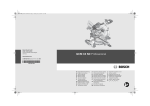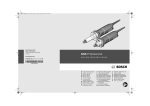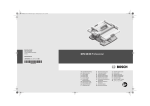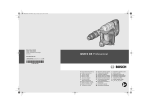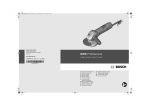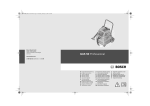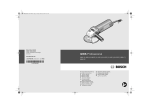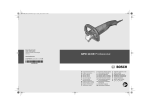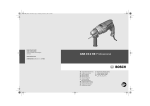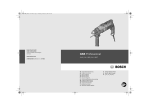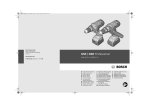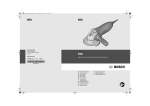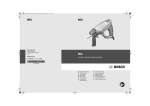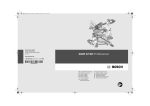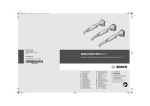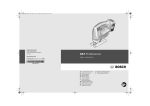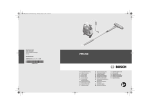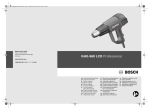Download GTS 10 J Professional - Tooled
Transcript
OBJ_BUCH-1325-001.book Page 1 Saturday, January 22, 2011 12:54 PM Robert Bosch GmbH Power Tools Division 70745 Leinfelden-Echterdingen Germany GTS 10 J Professional www.bosch-pt.com 1 609 929 X56 (2011.01) PS / 547 UNI de en fr es pt it nl Originalbetriebsanleitung Original instructions Notice originale Manual original Manual original Istruzioni originali Oorspronkelijke gebruiksaanwijzing da Original brugsanvisning sv Bruksanvisning i original no Original driftsinstruks fi Alkuperäiset ohjeet el tr pl cs sk hu ru Πρωτότυπο οδηγιών χρήσης Orijinal işletme talimat Instrukcja oryginalna Původní návod k používání Pôvodný návod na použitie Eredeti használati utasítás Оригинальное руководство по эксплуатации uk Оригінальна інструкція з експлуатації ro Instrucţiuni originale bg Оригинална инструкция sr sl hr et lv lt ar fa Originalno uputstvo za rad Izvirna navodila Originalne upute za rad Algupärane kasutusjuhend Instrukcijas oriģinālvalodā Originali instrukcija ΔϴϠλϷ ϞϴϐθΘϟ ΕΎϤϴϠόΗ ̶Ϡλ έΎ̯ ίήσ ̵ΎϤϨϫέ OBJ_BUCH-1325-001.book Page 3 Saturday, January 22, 2011 12:54 PM |3 1 2 3 4 5 6* 7 8 9 10 11 4 4 12 13 20 19 18 17 16 15 12 14 21 22 23 Bosch Power Tools GTS 10 J Professional 1 609 929 X56 | (22.1.11) OBJ_BUCH-1325-001.book Page 4 Saturday, January 22, 2011 12:54 PM 4| 11 30 24 33 1 609 929 X56 | (22.1.11) 12 32 31 25 12 26 30 27 28 2 29 Bosch Power Tools OBJ_BUCH-1325-001.book Page 5 Saturday, January 22, 2011 12:54 PM |5 * * A Bosch Power Tools 24 34 1 609 929 X56 | (22.1.11) OBJ_BUCH-1325-001.book Page 6 Saturday, January 22, 2011 12:54 PM 6| B 6* 8 6* 8 25 25 C D 10 38 37 10 35 36 11 38 E1 E2 5 39 28 5 3 3 1 609 929 X56 | (22.1.11) 53 40 Bosch Power Tools OBJ_BUCH-1325-001.book Page 7 Saturday, January 22, 2011 12:54 PM |7 F 41 31 G H 7 12 31 32 12 I GTA 60 W Professional Bosch Power Tools GTA 600 Professional 1 609 929 X56 | (22.1.11) OBJ_BUCH-1325-001.book Page 8 Saturday, January 22, 2011 12:54 PM 8| J1 J2 6 24 22 43 J3 J4 26 46 44 42 max. 5 mm 45 K L 3 48 47 49 50 18 1 609 929 X56 | (22.1.11) 17 Bosch Power Tools OBJ_BUCH-1325-001.book Page 9 Saturday, January 22, 2011 12:54 PM |9 M 15 2 1 14 N 10 51 14 26 1 O 35 27 37 10 P 26 25 Bosch Power Tools 1 609 929 X56 | (22.1.11) OBJ_BUCH-1325-001.book Page 10 Saturday, January 22, 2011 12:54 PM 10 | Q1 Q2 20 52 20 R 3 10 10 37 23 S 5 28 53 49 1 609 929 X56 | (22.1.11) Bosch Power Tools OBJ_BUCH-1325-001.book Page 11 Saturday, January 22, 2011 12:54 PM | 11 T1 T2 55 58 47 54 56 18 17 57 U 60 59 Bosch Power Tools 60 59 1 609 929 X56 | (22.1.11) OBJ_BUCH-1325-001.book Page 12 Saturday, January 22, 2011 12:54 PM 12 | V 51 62 W X 1 24 27 61 64 63 Y1 Y2 65 38 66 6 31 33 1 609 929 X56 | (22.1.11) Bosch Power Tools OBJ_BUCH-1325-001.book Page 13 Saturday, January 22, 2011 12:54 PM | 13 Y3 67 Y4 23 22 10 Y5 68 21 68 69 3 68 64 Y6 30 Bosch Power Tools 37 30 1 609 929 X56 | (22.1.11) OBJ_BUCH-1325-001.book Page 14 Saturday, January 22, 2011 12:54 PM 14 | Z 1 609 929 X56 | (22.1.11) Bosch Power Tools OBJ_BUCH-1325-001.book Page 34 Saturday, January 22, 2011 12:54 PM 34 | English Safety Notes en General Power Tool Safety Warnings When using electric tools basic safety precautions should always be followed to reduce the risk of fire, electric shock and personal injury including the following. WARNING Read all these instructions before attempting to operate this product and save these instructions. The term “power tool” in the warnings refers to your mains-operated (corded) power tool or battery-operated (cordless) power tool. 1) Work area safety a) Keep work area clean and well lit. Cluttered or dark areas invite accidents. b) Do not operate power tools in explosive atmospheres, such as in the presence of flammable liquids, gases or dust. Power tools create sparks which may ignite the dust or fumes. c) Keep children and bystanders away while operating a power tool. Distractions can cause you to lose control. 2) Electrical safety a) Power tool plugs must match the outlet. Never modify the plug in any way. Do not use any adapter plugs with earthed (grounded) power tools. Unmodified plugs and matching outlets will reduce risk of electric shock. b) Avoid body contact with earthed or grounded surfaces, such as pipes, radiators, ranges and refrigerators. There is an increased risk of electric shock if your body is earthed or grounded. c) Do not expose power tools to rain or wet conditions. Water entering a power tool will increase the risk of electric shock. 1 609 929 X56 | (22.1.11) d) Do not abuse the cord. Never use the cord for carrying, pulling or unplugging the power tool. Keep cord away from heat, oil, sharp edges and moving parts. Damaged or entangled cords increase the risk of electric shock. e) When operating a power tool outdoors, use an extension cord suitable for outdoor use. Use of a cord suitable for outdoor use reduces the risk of electric shock. f) If operating a power tool in a damp location is unavoidable, use a residual current device (RCD) protected supply. Use of an RCD reduces the risk of electric shock. 3) Personal safety a) Stay alert, watch what you are doing and use common sense when operating a power tool. Do not use a power tool while you are tired or under the influence of drugs, alcohol or medication. A moment of inattention while operating power tools may result in serious personal injury. b) Use personal protective equipment. Always wear eye protection. Protective equipment such as dust mask, non-skid safety shoes, hard hat, or hearing protection used for appropriate conditions will reduce personal injuries. c) Prevent unintentional starting. Ensure the switch is in the off-position before connecting to power source and/or battery pack, picking up or carrying the tool. Carrying power tools with your finger on the switch or energising power tools that have the switch on invites accidents. d) Remove any adjusting key or wrench before turning the power tool on. A wrench or a key left attached to a rotating part of the power tool may result in personal injury. Bosch Power Tools OBJ_BUCH-1325-001.book Page 35 Saturday, January 22, 2011 12:54 PM English | 35 e) Do not overreach. Keep proper footing and balance at all times. This enables better control of the power tool in unexpected situations. f) Keep cutting tools sharp and clean. Properly maintained cutting tools with sharp cutting edges are less likely to bind and are easier to control. f) Dress properly. Do not wear loose clothing or jewellery. Keep your hair, clothing and gloves away from moving parts. Loose clothes, jewellery or long hair can be caught in moving parts. g) Use the power tool, accessories and tool bits etc. in accordance with these instructions, taking into account the working conditions and the work to be performed. Use of the power tool for operations different from those intended could result in a hazardous situation. g) If devices are provided for the connection of dust extraction and collection facilities, ensure these are connected and properly used. Use of dust collection can reduce dust-related hazards. 4) Power tool use and care a) Do not force the power tool. Use the correct power tool for your application. The correct power tool will do the job better and safer at the rate for which it was designed. b) Do not use the power tool if the switch does not turn it on and off. Any power tool that cannot be controlled with the switch is dangerous and must be repaired. c) Disconnect the plug from the power source and/or the battery pack from the power tool before making any adjustments, changing accessories, or storing power tools. Such preventive safety measures reduce the risk of starting the power tool accidentally. d) Store idle power tools out of the reach of children and do not allow persons unfamiliar with the power tool or these instructions to operate the power tool. Power tools are dangerous in the hands of untrained users. e) Maintain power tools. Check for misalignment or binding of moving parts, breakage of parts and any other condition that may affect the power tool’s operation. If damaged, have the power tool repaired before use. Many accidents are caused by poorly maintained power tools. Bosch Power Tools 5) Service a) Have your power tool serviced by a qualified repair person using only identical replacement parts. This will ensure that the safety of the power tool is maintained. Safety Warnings for Table Saws f Never stand on the power tool. Serious injuries can occur when the power tool tips over or when inadvertently coming into contact with the saw blade. f Take care that the blade guard operates properly and can move freely. Always adjust the blade guard in such a manner that it faces loosely against the workpiece when sawing. Never clamp the blade guard when it is open. f Keep hands away from the cutting area while the machine is running. Danger of injury when coming in contact with the saw blade. f Never reach behind the saw blade in order to hold the workpiece, remove saw dust/wood chips or for any other reason. The clearance of your hand to the rotating saw blade is too small. f Guide the workpiece against the saw blade only when the machine is switched on. Otherwise there is damage of kickback, when the saw blade becomes wedged in the workpiece. f Keep handles dry, clean, and free from oil and grease. Greasy, oily handles are slippery causing loss of control. 1 609 929 X56 | (22.1.11) OBJ_BUCH-1325-001.book Page 36 Saturday, January 22, 2011 12:54 PM 36 | English f Operate the power tool only when the work area to the workpiece is clear of any adjusting tools, wood chips, etc. Small pieces of wood or other objects that come in contact with the rotating saw blade can strike the operator with high speed. f Only saw one workpiece at a time. Workpieces placed on top or aside of each other can cause the saw blade to jam or the workpieces to move against each other while sawing. f Always use the parallel guide or the angle guide. This improves the cutting accuracy and reduces the possibility of saw blade binding. f Use the machine for grooving or rebating only with an appropriately suitable protective device (e. g. a tunnel blade guard). f Do not use the machine for cutting slots. f Use the machine only for cutting the materials listed under Intended Use. Otherwise, the machine can be subject to overload. f If the saw blade should become jammed, switch the machine off and hold the workpiece until the saw blade comes to a complete stop. To prevent kickback, the workpiece may not be moved until after the machine has come to a complete stop. Correct the cause for the jamming of the saw blade before restarting the machine. f Do not use dull, cracked, bent or damaged saw blades. Unsharpened or improperly set saw blades produce narrow kerf causing excessive friction, blade binding and kickback. f Always use saw blades with correct size and shape (diamond versus round) of arbor holes. Saw blades that do not match the mounting hardware of the saw will run eccentrically, causing loss of control. f Do not use high speed steel (HSS) saw blades. Such saw blades can easily break. 1 609 929 X56 | (22.1.11) f Do not touch the saw blade after working before it has cooled. The saw blade becomes very hot while working. f Never operate the machine without the insert plate. Replace a defective insert plate. Without flawless insert plates, injuries are possible from the saw blade. f Check the cable regularly and have a damaged cable repaired only through an authorised customer service agent for Bosch power tools. Replace damaged extension cables. This will ensure that the safety of the power tool is maintained. f Store the machine in a safe manner when not being used. The storage location must be dry and lockable. This prevents the machine from storage damage, and from being operated by untrained persons. f Never leave the machine before it has come to a complete stop. Cutting tools that are still running can cause injuries. f Never use the machine with a damaged cable. Do not touch the damaged cable and pull the mains plug when the cable is damaged while working. Damaged cables increase the risk of an electric shock. Products sold in GB only: Your product is fitted with an BS 1363/A approved electric plug with internal fuse (ASTA approved to BS 1362). If the plug is not suitable for your socket outlets, it should be cut off and an appropriate plug fitted in its place by an authorised customer service agent. The replacement plug should have the same fuse rating as the original plug. The severed plug must be disposed of to avoid a possible shock hazard and should never be inserted into a mains socket elsewhere. Products sold in AUS and NZ only: Use a residual current device (RCD) with a rated residual current of 30 mA or less. Bosch Power Tools OBJ_BUCH-1325-001.book Page 37 Saturday, January 22, 2011 12:54 PM English | 37 Symbols The following symbols can be important for the operation of your power tool. Please memorise the symbols and their meanings. The correct interpretation of the symbols helps you operate the power tool better and more secure. Symbol Meaning f Keep hands away from the cutting area while the machine is running. Danger of injury when coming in contact with the saw blade. f Wear a dust respirator. f Wear ear protectors. Exposure to noise can cause hearing loss. f Wear safety goggles. Do not dispose of power tools into household waste! Only for EC countries: According to the European Guideline 2002/96/EC for Waste Electrical and Electronic Equipment and its implementation into national right, power tools that are no longer usable must be collected separately and disposed of in an environmentally correct manner. Observe the dimensions of the saw blade. The hole diameter must match the tool spindle without play. Do not use reducers or adapters. When changing the saw blade, pay attention that the kerf width is not less than 2.3 mm and the blade thickness not greater than 2.3 mm. Otherwise, there is danger that the riving knife (2.3 mm) becomes wedged in the workpiece. The maximal possible workpiece height is 79 mm. Bosch Power Tools 1 609 929 X56 | (22.1.11) OBJ_BUCH-1325-001.book Page 38 Saturday, January 22, 2011 12:54 PM 38 | English Symbol Meaning Left side Right side Indicates the rotation direction of the handwheel for lowering (transport position) and raising (working position) the saw blade. Indicates the position of the locking lever for locking the saw blade and for adjusting the bevel angle (saw blade tiltable). If required, lubricate the power tool at the indicated locations. Product Description and Specifications Read all safety warnings and all instructions. Failure to follow the warnings and instructions may result in electric shock, fire and/or serious injury. Intended Use The power tool is intended as a stationary machine for making straight lengthways and crossways cuts in hard and softwood, as well as in particle and fibre board. In this, mitre angles from –60° to +60° as well as bevel angles from –2° to 47° are possible. When using appropriate saw blades, sawing aluminium profiles and plastic is also possible. Product Features The numbering of the components shown refers to the representation of the power tool on the graphic pages. 1 Scale for clearance of the saw blade to the parallel guide 10 2 Guide groove for parallel guide 10 3 Angle stop 4 Recessed handles 5 Guide groove for angle stop 6 Blade guard* 7 Vacuum connection on the blade guard 8 Clamping lever for locking the blade guard 9 Saw table 10 Parallel guide 11 V-guide groove of parallel guide 12 Mounting holes 13 Carrying handle 14 Saw-Table extension 15 Tensioning lever for saw-table extension 16 Fastening bracket for saw stand GTA 600 17 Locking lever for adjustment of bevel angles 18 Handwheel 19 Crank for lowering and raising the saw blade 1 609 929 X56 | (22.1.11) Bosch Power Tools OBJ_BUCH-1325-001.book Page 39 Saturday, January 22, 2011 12:54 PM English | 39 20 Safety flap of On/Off switch 50 Angle indicator on the angle guide 21 Allen key (5 mm) 51 Saw-table clearance indicator 22 Ring spanner (23 mm) 52 ON button 23 Push stick 53 Knurled nut for profile rail 24 Insert plate 54 Phillips screw for adjustment of stop 55 25 Riving knife 55 Stop for 0° mitre angle 26 Saw blade 56 Screw for bevel angle indicator 27 Lens 57 Phillips screw for adjustment of stop 58 28 Profile rail 58 Stop for 45° mitre angle 29 Cable holder 59 Front Allen screws (5 mm) for parallelism adjustment of the saw blade 30 Retaining bracket for storage of the auxiliary parallel guide 31 Sawdust ejector 60 Rear Allen screws (5 mm) for parallelism adjustment of the saw blade 32 Extraction adapter 61 Screw for saw-table clearance indicator 33 Fixture for storage of the blade guard 62 Screw for parallel guide clearance indicator 34 Insert-plate notches 63 Adjusting screws for insert plate 35 Clamping handle of the parallel guide 64 Allen key (2 mm) 36 V-guide groove of parallel guide 65 Holder for storage of “auxilliary parallel guide fastening kit” 37 Auxiliary parallel guide 38 “Auxiliary parallel guide” fastening kit 39 Guide rail of the angle stop 40 “Profile rail ”fastening kit 41 Fastening screw for sawdust ejector 42 Clamping nut 43 Spindle lock lever 44 Clamping flange 45 Tool spindle 46 Mounting flange 47 Indicator for bevel angle 48 Scale for bevel angle 66 Retaining clamp for storage of the extraction adapter 67 Fastening nut for the ring spanner and for attaching the push stick 68 Holder for storage of the Allen key 69 Retaining clamp for storage of the angle stop * depending on country version Accessories shown or described are not part of the standard delivery scope of the product. A complete overview of accessories can be found in our accessories program. 49 Locking knob for various mitre angles Bosch Power Tools 1 609 929 X56 | (22.1.11) OBJ_BUCH-1325-001.book Page 40 Saturday, January 22, 2011 12:54 PM 40 | English Technical Data Table saw GTS 10 J Professional 3 601 M30 500 3 601 M30 530 3 601 M30 570 3 601 M30 590 3 601 M30 5P0 3 601 M30 560 W 1800 1650 min-1 3650 3650 z z mm 578 x 706 x 330 578 x 706 x 330 kg 26 26 /II /II Article number Rated power input No-load speed Reduced starting current Dimensions (incl. removable product features) (Width x depth x height) Weight according to EPTA-Procedure 01/2003 Protection class Maximum workpiece dimensions, see page 46. The values given are valid for a nominal voltage [U] of 230 V. For different voltages and models for specific countries, these values can vary. Please observe the article number on the type plate of your machine. The trade names of the individual machines may vary. Declaration of Conformity Dimension of suitable saw blades Saw blade diameter mm 254 Blade body thickness mm 1.7–1.9 Tooth thickness/setting, min. mm 2.6 mm 30 Mounting hole diameter Noise Information Measured sound values determined according to EN 61029. Typically the A-weighted noise levels of the product are: Sound pressure level 103 dB(A); Sound power level 116 dB(A). Uncertainty K =3 dB. Wear hearing protection! We declare under our sole responsibility that the product described under “Technical Data” is in conformity with the following standards or standardization documents: EN 61029 according to the provisions of the directives 2004/108/EC, 2006/42/EC. EC Type Certification No. MSR 1034 by notified testing agency No. 0366. Technical file at: Robert Bosch GmbH, Dept. PT/ESC, D-70745 Leinfelden-Echterdingen Dr. Egbert Schneider Senior Vice President Engineering Dr. Eckerhard Strötgen Head of Product Certification Robert Bosch GmbH, Power Tools Division D-70745 Leinfelden-Echterdingen Leinfelden, 24.01.2011 1 609 929 X56 | (22.1.11) Bosch Power Tools OBJ_BUCH-1325-001.book Page 41 Saturday, January 22, 2011 12:54 PM English | 41 Assembly f Avoid unintentional starting of the machine. During assembly and for all work on the machine, the power plug must not be connected to the mains supply. Delivery Scope Please also observe the representation of the delivery scope at the beginning of the operating instructions. Before starting the operation of the machine for the first time, check if all parts listed below have been supplied: – Table saw with mounted saw blade 26 and riving knife 25 – Angle stop 3 – Profile rail 28 – Fastening kit “profile rail” 40 (guide plate, knurled nut, screw, washer) – Parallel guide 10 – Auxiliary parallel guide 37 – “Auxiliary parallel guide” fastening kit 38 (3 fastening screws, 3 washers, 3 wing nuts) – Blade guard 6* – Allen key 21 – Allen key 64 – Ring spanner 22 – Push stick 23 – Insert plate 24 – Extraction adapter 32 (* depending on country version) Note: Check the power tool for possible damage. Before further use of the machine, check that all protective devices are fully functional. Any lightly damaged parts must be carefully checked to ensure flawless operation of the tool. All parts must be properly mounted and all conditions fulfilled that ensure faultless operation. Damaged protective devices and parts must be immediately replaced by an authorised service centre. Bosch Power Tools Mounting Individual Components – Carefully remove all parts included in the delivery from their packaging. Remove all packaging material from the machine and the accessories provided. – Take care that the packaging material under the motor block es removed. The following product features are fastened directly to the housing: Push stick 23, ring spanner 22, allen key 21 and 64, parallel guide 10, angle guide 3, extraction adapter 32, auxiliary parallel guide 37 with fastening kit 38, blade guard 6. – Carefully remove these product features from their storage locations. Also see figures Y1–Y6. Mounting the Insert Plate (see figure A) – Hook insert plate 24 into the rear insert-plate notches 34 of the tool basin. – Guide the insert plate down. – Press on the insert plate until it engages at the front in the tool basin. The front side of the insert plate 24 must be flush with or somewhat lower than the saw table; the rear side must be flush with or somewhat above the saw table. (also see “Adjusting the Level of the Insert Plate”, page 48) Mounting the Blade Guard (see figure B) – Turn crank 19 clockwise to the stop, so that the saw blade 26 is in the highest possible position above the saw table. – Pull the riving knife 25 upward to the stop. – Insert the blade guard 6 into the recess in riving knife 25. – Tighten the clamping lever 8. The clamping force must be adjusted in such a manner that the blade guard can always be aligned according to the height of the workpiece. 1 609 929 X56 | (22.1.11) OBJ_BUCH-1325-001.book Page 42 Saturday, January 22, 2011 12:54 PM 42 | English Note: Clamping lever 8 is indexed (adjustable), allowing it to be set to an ergonomically favourable or space-saving position. With the clamping lever tightened, pull its lever away from the blade guard, turn it to the desired position and allow it to engage again. Mounting the Parallel Guide (see figure C) The parallel guide 10 can be positioned either left or right from the saw blade. – Loosen clamping handle 35 of parallel guide 10. This releases V-guide 36. – Firstly, mount the parallel guide via the Vguide in guide groove 11 of the saw table. Now, position the parallel guide into the front guide groove 2 of the saw table. The parallel guide can now be moved to any position. – To lock the parallel guide, press the clamping handle 35 down. Dust/Chip Extraction Dusts from materials such as lead-containing coatings, some wood types, minerals and metal can be harmful to one’s health. Touching or breathing-in the dusts can cause allergic reactions and/or lead to respiratory infections of the user or bystanders. Certain dusts, such as oak or beech dust, are considered as carcinogenic, especially in connection with wood-treatment additives (chromate, wood preservative). Materials containing asbestos may only be worked by specialists. – Always use dust extraction. – Provide for good ventilation of the working place. – It is recommended to wear a P2 filter-class respirator. Observe the relevant regulations in your country for the materials to be worked. Mounting the Auxiliary Parallel Guide (see figure D) The dust/chip extraction can be blocked by dust, chips or workpiece fragments. When sawing narrow workpieces and bevel angles, the auxiliary parallel guide 37 must be mounted to parallel guide 10. – Switch the machine off and pull the mains plug from the socket outlet. – Wait until the saw blade has come to a complete stop. – Determine the cause of the blockage and correct it. The auxiliary parallel guide can be mounted left or right from parallel guide 10, as required. For assembly, use the “auxiliary parallel guide” fastening kit 38. (3 fastening screws, 3 washers, 3 wing nuts) – Insert the fastening screws through the lateral holes in the parallel guide 10. The heads of the screws serve as a guide for the auxiliary parallel guide. – Move the auxiliary parallel guide 37 over the heads of the fastening screws. – Mount the washers to the fastening screws and tighten them with the wing nuts . Mounting the Angle Stop (see figures E1 – E2) – Insert the guide rail 39 of the angle stop 3 into one of the guide grooves 5 of the saw table intended for this purpose. For improved placement of long workpieces, the angle stop can be extended with profile rail 28. – If required, mount the profile rail to the angle stop with fastening kit 40. 1 609 929 X56 | (22.1.11) f Prevent dust accumulation at the workplace. Dusts can easily ignite. f To avoid the danger of fire when sawing aluminium, empty the sawdust ejector and do not work with dust/chip extraction. Emptying the Sawdust Ejector (see figure F) The sawdust ejector 31 can be emptied for removal of workpiece fragments and large chips. – Switch the machine off and pull the mains plug from the socket outlet. – Wait until the saw blade has come to a complete stop. – Loosen fastening screw 41 with Allen key 21. – Pull out sawdust ejector 31 and remove workpiece fragments and chips. – Mount the sawdust ejector to the power tool again. Bosch Power Tools OBJ_BUCH-1325-001.book Page 43 Saturday, January 22, 2011 12:54 PM English | 43 External Dust Extraction (see figure G) To connect a vacuum cleaner to the sawdust ejector 31, use the supplied extraction adapter 32. – Firmly attach the extraction adapter 32 and the vacuum hose. – Additionally, a dust extraction system can be connected to vacuum connection 7 to increase the extraction performance. The vacuum cleaner must be suitable for the material being worked. When vacuuming dry dust that is especially detrimental to health or carcinogenic, use a special vacuum cleaner. Stationary or Flexible Mounting f To ensure safe handling, the machine must be mounted on a level and stable surface (e. g., workbench) prior to using. Mounting to a Working Surface (see figure H) – Fasten the power tool with suitable screw fasteners to the working surface. The mounting holes 12 serve for this purpose. Mounting to a Bosch Saw Stand (see figure I) With the height-adjustable legs, Bosch saw stands (e. g. GTA 60 W, GTA 600) provide firm support for the power tool on any surface. f Read all safety warnings and instructions included with the worktable. Failure of observing safety warnings and instructions can lead to electrical shock, fire and/or cause serious injuries. f Assemble the worktable properly before mounting the power tool. Perfect assembly is important in order to prevent the risk of collapsing. – Mount the power tool on the saw stand in the transport position. Changing the Saw Blade (see figures J1 – J4) f Before any work on the machine itself, pull the mains plug. f When mounting the saw blade, wear protective gloves. Danger of injury when touching the saw blade. Use only saw blades whose maximum permitted speed is higher than the no-load speed of the power tool. Use only saw blades that correspond with the characteristic data given in these operation instructions and that are tested and marked in accordance with EN 847-1. Use only saw blades recommended by the tool manufacturer, and suitable for sawing the materials to be cut. Removing the Saw Blade – Using a screwdriver, raise the insert plate 24 at the front and remove it from the tool basin. – Turn crank 19 clockwise to the stop, so that the saw blade 26 is in the highest possible position above the saw table. – Tilt the protection guard 6 toward the rear to the stop. – Turn the clamping nut 42 with the ring spanner 22 (23 mm) and at the same time, pull the spindle lock lever 43 until it engages. – Keep the spindle lock lever pulled and unscrew the clamping nut turning in anticlockwise direction. – Remove the clamping flange 44. – Remove the saw blade 26. Mounting the Saw Blade If required, clean all parts to be mounted prior to assembly. – Place the new saw blade onto the supporting flange 46 of the tool spindle 45. Note: Do not use saw blades that are too small. The clearance between saw blade and riving knife must not exceed 5 mm (max.). Bosch Power Tools 1 609 929 X56 | (22.1.11) OBJ_BUCH-1325-001.book Page 44 Saturday, January 22, 2011 12:54 PM 44 | English f When mounting the saw blade, pay attention that the cutting direction of the teeth (arrow direction on the saw blade) corresponds with the direction of the arrow on the blade guard! – Mount the clamping flange 44 and the clamping nut 42. – Turn the clamping nut 42 with the ring spanner 22 (23 mm) and at the same time, pull the spindle lock lever 43 until it engages. – Tighten the clamping nut in clockwise direction. (Tightening torque approx. 15–23 Nm) – Reinsert the insert plate 24. – Tilt protection guard 6 down again. Operation f Before any work on the machine itself, pull the mains plug. Transport and Working Position of the Saw Blade Transport Position – Turn the handwheel 18 in anticlockwise direction until the teeth of the saw blade 26 are positioned below the saw table 9. – Slide the table extension 14 completely inward. Press tensioning lever 15 downward. The saw-table extension is now locked. For additional information on transport, see page 49. Working Position – Turn the crank 19 clockwise, until the teeth of the saw blade 26 are positioned above the workpiece. Note: Take care that the blade guard is properly positioned. When sawing, it must always face against the workpiece. 1 609 929 X56 | (22.1.11) Adjusting the Cutting Angle To ensure precise cuts, the basic adjustment of the machine must be checked and adjusted as necessary after intensive use (see “Checking and Adjusting the Basic Adjustment”, page 47). Adjusting Bevel Angles (Saw Blade) (see figure K) The bevel angle can be set in the range from –2° to 47°. – Turn locking lever 17 in anticlockwise direction. Note: By completely loosening the locking knob, the saw blade tilts approx. to the 30° position by means of gravity force. – Push or pull handwheel 18 alongside the connecting link until the angle indicator 47 indicates the desired bevel angle. – Hold the handwheel in this position and tighten locking lever 17 again. For quick and precise setting of the standard 0° and 45° angles, factory-set stops have been provided for. Adjusting Mitre Angles (Angle Stop) (see figure L) The mitre angle can be set in the range from 60° (left side) to 60° (right side). – Loosen the locking knob 49 in case it is tightened. – Turn the angle stop until the angle indicator 50 indicates the requested mitre angle. – Tighten the locking knob 49 again. Increasing the Size of the Saw Table (see figure M) Long workpieces must be underlaid or supported at their free end. – Completely pull tensioning lever 15 of the saw-table extension upward. – Pull out the saw-table extension 14 to the desired length. – Press tensioning lever 15 downward. The saw-table extension is now locked. Bosch Power Tools OBJ_BUCH-1325-001.book Page 45 Saturday, January 22, 2011 12:54 PM English | 45 Adjusting the Parallel Guide The parallel guide 10 can be positioned either left (black scale) or right (silver scale) from the saw blade. The mark in the lens 27 indicates the set clearance of the parallel fence to the saw blade on the scale 1. Position the parallel guide on the desired side of the saw blade (see “Mounting the Parallel Guide”, page 42). With the Saw Table not Extended – Loosen clamping handle 35 of parallel guide 10. Move the parallel guide until the mark in the lens 27 indicates the desired clearance to the saw blade. When the saw table is not extended, the bottom labelling of the silver scale applies 1. – To lock the parallel guide, press clamping handle 35 down again. With the Saw Table Extended (see figure N) – Position the parallel guide on the right side of the saw blade. Move the parallel guide until the mark in the lens 27 indicates 26 cm on the bottom scale. To lock the parallel guide, press clamping handle 35 down again. – Completely pull tensioning lever 15 of the saw-table extension upward. – Pull saw-table extension 14 outward until clearance indicator 51 indicates the desired clearance to the saw blade on the top scale. – Press tensioning lever 15 downward. The saw-table extension is now locked. Adjusting the Auxiliary Parallel Guide (see figure O) When sawing narrow workpieces and bevel angles, the auxiliary parallel guide 37 must be mounted to parallel guide 10. The auxiliary parallel guide can be mounted left or right to parallel guide 10 as required. Bosch Power Tools When sawing short workpieces, these can become jammed between the parallel guide and the saw blade, be caught by the rotating saw blade, and be thrown from the machine. Therefore, adjust the auxiliary parallel guide in such a manner that its guiding end is located between the front saw blade tooth and the saw blade centre. – For this, loosen all wing nuts and move the auxiliary parallel guide until only the two front screws can be used for fastening. – Tighten the wing nuts again. Adjusting the Riving Knife The riving knife 25 prevents the saw blade 26 from becoming jammed in the saw cut. Otherwise, there is danger of kickback when the saw blade becomes wedged in the workpiece. Always pay attention that the riving knife is properly adjusted: – The radial clearance between saw blade and riving knife may not exceed 5 mm (max.). – The thickness of the riving knife must be smaller than the cutting width and greater than the blade thickness. – The riving knife must always be in a line to the saw blade. – For normal separating cuts, the riving knife must always be in the highest possible position. The machine is supplied with the riving knife correctly adjusted. Adjusting the height of the riving knife (see figure P) For sawing grooves, the height of the riving knife must be adjusted. f Use the machine for grooving or rebating only with an appropriately suitable protective device (e. g. a tunnel blade guard). – Loosen clamping lever 8 until blade guard 6 can easily be pulled from the recess in the riving knife 25. To protect the blade guard against damage, deposit it in the provided holding fixture 33 on the housing (also see figure Y1). 1 609 929 X56 | (22.1.11) OBJ_BUCH-1325-001.book Page 46 Saturday, January 22, 2011 12:54 PM 46 | English – Turn crank 19 clockwise to the stop, so that the saw blade 26 is in the highest possible position above the saw table. – Push the riving knife 25 down to the stop. Position of the Operator (see figure R) Starting Operation – Keep hands, fingers and arms away from the rotating saw blade. f Observe the mains voltage! The voltage of the power source must correspond with the data on the type plate of the machine. Switching On (see figure Q1) – Tilt safety flap 20 upward. – To start the operation, press the green ON pushbutton 52. – Tilt safety flap 20 down again. Switching Off (see figure Q2) f Do not stand in a line with the saw blade in front of the machine. Always stand aside of the saw blade. This protects your body against possible kickback. Observe the following instructions: – Hold the workpiece securely with both hands and press it firmly against the saw table. – When sawing narrow workpieces and bevel angles, always use the supplied hold-down stick 23 and the auxiliary parallel guide 37. Maximum Workpiece Dimensions Bevel angle Max. workpiece height [mm] Power Failure 0° 79 The ON/OFF switch is a so-called non-voltage switch, which prevents the power tool from restarting after a power failure (e. g., when the mains plug is pulled during operation). 45° 56 – Press on the safety flap 20. To restart the operation of the machine afterwards, the green ON button 52 must be pressed again. Working Advice General Sawing Instructions f For all cuts, it must first be ensured that the saw blade at no time can come in contact with the stops or other machine parts. f Use the machine for grooving or rebating only with an appropriately suitable protective device (e. g. a tunnel blade guard). f Do not use the machine for cutting slots. Protect the saw blade against impact and shock. Do not subject the saw blade to lateral pressure. The riving knife must be in alignment with the saw blade to avoid jamming of the workpiece. Do not saw warped/bent workpieces. The workpiece must always have a straight edge to face against the parallel guide. Always keep/store the push stick with the power tool. 1 609 929 X56 | (22.1.11) Sawing Sawing Straight Cuts – Adjust the parallel guide 10 to the requested cutting width. (see “Adjusting the Parallel Guide”, page 45) – Position the workpiece on the saw table in front of the blade guard 6. – Raise or lower the saw blade with the crank 19 so that the upper saw teeth project above the workpiece surface. – Adjust the blade guard according to the workpiece height. When sawing, the blade guard must always face lightly against the workpiece. – Switch on the machine. – Saw through the workpiece applying uniform feed. – Switch off the machine and wait until the saw blade has come to a complete stop. Sawing Bevel Angles – Adjust the desired bevel angle. (see “Adjusting Bevel Angles”, page 44) – Follow the worksteps in section “Sawing Straight Cuts” accordingly. Bosch Power Tools OBJ_BUCH-1325-001.book Page 47 Saturday, January 22, 2011 12:54 PM English | 47 Sawing Mitre Angles (see figure S) Adjusting: (see figure T2) – Adjust the requested mitre angle (see “Adjusting Mitre Angles”, page 44) – Place the workpiece against profile rail 28. The profile may not be on the cutting line. If so, loosen knurled nut 53 and move the profile. – Raise or lower the saw blade with the crank 19 so that the upper saw teeth project above the workpiece surface. – Adjust the blade guard according to the workpiece height. When sawing, the blade guard must always face lightly against the workpiece. – Switch on the machine. – With one hand, press the workpiece against the profile rail and with the other hand, slowly move the angle stop via locking knob 49 toward the front in guide groove 5. – Switch off the machine and wait until the saw blade has come to a complete stop. – Loosen screw 54. The 0° stop 55 can now be moved. – Loosen locking lever 17. – Move handwheel 18 toward the 0° stop until the leg of the angle gauge is flush with the saw blade over the complete length. – Hold the handwheel in this position and tighten locking lever 17 again. – Tighten screw 54 again. Checking and Adjusting the Basic Adjustment To ensure precise cuts, the basic adjustment of the machine must be checked and adjusted as necessary after intensive use. A certain level of experience and appropriate specialty tools are required for this. A Bosch after-sales service station will handle this maintenance task quickly and reliably. Setting the Stops for Standard 0°/ 45° Bevel Angles – Bring the power tool into the working position. – Adjust to a 0° bevel angle. – Tilt the protection guard 6 toward the rear to the stop. Checking: (see figure T1) – Set an angle gauge to 90° and place it on the saw table 9. The leg of the angle gauge must be flush with the saw blade 26 over the complete length. Bosch Power Tools When the angle indicator 47 is not in line with the 0° mark of scale 48, loosen screw 56 with a commercially available Phillips screwdriver and align the angle indicator alongside the 0° mark. Repeat the above mentioned worksteps accordingly for the 45° bevel angle (loosening screw 57; moving the 45° stop 58). In this, the angle indicator 47 must not be misadjusted. Parallelism of the Saw Blade to the Guide Grooves of the Angle Stop (see figure U) – Bring the power tool into the working position. – Tilt the protection guard 6 toward the rear to the stop. Checking: – With a pencil, mark the first visible saw tooth on the left side that projects above the insert plate. – Set an angle gauge to 90° and place it on the edge of the guide groove 5. – Move the leg of the angle gauge until it touches the marked saw tooth, and read the clearance between saw blade and guide groove. – Turn the saw blade until the marked tooth projects above the right side of the insert plate. – Move the angle gauge alongside the guide groove to the marked tooth. – Measure the clearance between the saw blade and guide groove again. Both clearances measured must be identical. 1 609 929 X56 | (22.1.11) OBJ_BUCH-1325-001.book Page 48 Saturday, January 22, 2011 12:54 PM 48 | English Adjusting: Adjusting the Lens of the Parallel Guide (see figure W) – Loosen Allen screws 59 at the front below the saw table and Allen screws 60 at the rear below the saw table with the supplied Allen key 21. – Carefully move the saw blade until it is parallel to guide groove 5. – Retighten all screws 59 and 60 again. – Bring the power tool into the working position. – Tilt the protection guard 6 toward the rear to the stop. – Move parallel guide 10 from the right until it touches the saw blade. Adjusting the Saw Table’s Clearance Indicator (see figure V) Checking: The mark of lens 27 must be in a line with the 0° mark of scale 1. – Position the parallel guide on the right side of the saw blade. Move the parallel guide until the mark in the lens 27 indicates 26 cm on the bottom scale. To lock the parallel guide, press clamping handle 35 down again. – Loosen tensioning lever 15 and pull the table extension out to the stop. Checking: On the upper scale 1, clearance indicator 51 must indicate the identical value as the mark in lens 27 on the bottom scale 1. Adjusting: – Loosen screw 61 with a Phillips screwdriver and align clearance indicator 51 alongside the 26 cm mark of the upper scale 1. 1 609 929 X56 | (22.1.11) Adjusting: – Loosen screw 62 using a Phillips screwdriver and align the clearance indicator alongside the 0° mark. Adjusting the Level of the Insert Plate (see figure X) Checking: The front side of the insert plate 24 must be flush with or somewhat lower than the saw table; the rear side must be flush with or somewhat above the saw table. Adjusting: – Remove the insert plate 24. – Adjust the correct level of the four adjusting screws 63 with the Allen key 64. Bosch Power Tools OBJ_BUCH-1325-001.book Page 49 Saturday, January 22, 2011 12:54 PM English | 49 Storage and Transport Storing Product Features (see figures Y1–Y6) For storage purposes, certain product features can be securely fastened to the power tool. – Loosen auxiliary parallel guide 37 from parallel guide 10. – Attach all loose tool parts to their storage locations on the housing. (see Table) Figure Product Feature Storage Location Y1 Blade guard 6 Insert into the recess of fixture 33 and tighten with clamping lever 8 Y2 “Auxiliary parallel guide” fastening kit 38 Clip into the holders 65 Y2 Extraction adapter 32 Insert into retaining clamp 66 Y3 Ring spanner 22 Fasten in tool depot with fastening nut 67 Y3 Push stick 23 Mount onto fastening nut 67 and fasten by turning Y4 Parallel guide 10 Turn guide around and hang it into the guide rails from below; tighten clamping handle 35 Allen key 21 Insert into holders 68 Y5 Allen key 64 Y5 Angle stop 3 Insert into retaining clamp 69 Y6 Auxiliary parallel guide 37 Insert into retaining brackets 30 (short side goes on top; long side toward the rear) Carrying the Power Tool Before transporting the power tool, the following steps must be carried out: – Bring the machine into the transport position. (see “Transport Position”, page 44) – Remove all accessories that cannot be mounted firmly to the power tool. If possible, place unused saw blades in an enclosed container for transport. – Slide the saw-table extension 14 completely to the rear and press tensioning lever 15 downward to lock it. Bosch Power Tools – Wind the mains cable around the cable holder 29. – For lifting or transport, use the recessed handles 4 or the carrying handle 13. f When transporting the power tool, use only the transport devices and never use the protective devices. f The power tool should always be carried by two persons in order to avoid back injuries. 1 609 929 X56 | (22.1.11) OBJ_BUCH-1325-001.book Page 50 Saturday, January 22, 2011 12:54 PM 50 | English Maintenance and Service Maintenance and Cleaning f Before any work on the machine itself, pull the mains plug. If the machine should fail despite the care taken in manufacturing and testing procedures, repair should be carried out by an after-sales service centre for Bosch power tools. In all correspondence and spare parts order, please always include the 10-digit article number given on the type plate of the machine. Cleaning – For safe and proper working, always keep the power tool and its ventilation slots clean. – Remove dust and chips after each working procedure by blowing out with compressed air or with a brush. Power Tool Lubrication Lubricants: SAE 10/SAE 20 engine oil – If required, lubricate the power tool at the indicated locations. (see figure Z) An authorized Bosch after-sales service agent will carry out this work quickly and reliably. Observe all applicable environmental regulations when disposing of old grease and solvents. Accessories Dust bag . . . . . . . . . . . . . . . . . . 2 610 015 511 Extraction adapter . . . . . . . . . . . 2 610 015 509 Y-adapter . . . . . . . . . . . . . . . . . . 2 610 015 513 Angle stop . . . . . . . . . . . . . . . . . 2 610 015 507 Push stick . . . . . . . . . . . . . . . . . 2 610 015 022 Saw stand GTA 60 W . . . . . . . . . 0 601 B12 000 Saw stand GTA 600 . . . . . . . . . 0 601 B22 001 Saw blades for wood and plate materials, panels and strips/mouldings Saw blade 254 x 30 mm, 40 teeth . . . . . . . . . . . . . . . . . . . 2 608 640 443 Saw blade 254 x 30 mm, 60 teeth . . . . . . . . . . . . . . . . . . . 2 608 640 444 Saw blades for plastic and non-ferrous metals Saw blade 254 x 30 mm, 80 teeth . . . . . . . . . . . . . . . . . . . 2 608 640 450 After-sales Service and Customer Assistance Our after-sales service responds to your questions concerning maintenance and repair of your product as well as spare parts. Exploded views and information on spare parts can also be found under: www.bosch-pt.com Our customer service representatives can answer your questions concerning possible applications and adjustment of products and accessories. Great Britain Robert Bosch Ltd. (B.S.C.) P.O. Box 98 Broadwater Park North Orbital Road Denham Uxbridge UB 9 5HJ Tel. Service: +44 (0844) 736 0109 Fax: +44 (0844) 736 0146 E-Mail: [email protected] 1 609 929 X56 | (22.1.11) Bosch Power Tools OBJ_BUCH-1325-001.book Page 51 Saturday, January 22, 2011 12:54 PM English | 51 Ireland Origo Ltd. Unit 23 Magna Drive Magna Business Park City West Dublin 24 Tel. Service: +353 (01) 4 66 67 00 Fax: +353 (01) 4 66 68 88 Australia, New Zealand and Pacific Islands Robert Bosch Australia Pty. Ltd. Power Tools Locked Bag 66 Clayton South VIC 3169 Customer Contact Center Inside Australia: Phone: +61 (01300) 307 044 Fax: +61 (01300) 307 045 Inside New Zealand: Phone: +64 (0800) 543 353 Fax: +64 (0800) 428 570 Outside AU and NZ: Phone: +61 (03) 9541 5555 www.bosch.com.au Bosch Headquarters Midrand, Gauteng Tel.: +27 (011) 6 51 96 00 Fax: +27 (011) 6 51 98 80 E-Mail: [email protected] Disposal The machine, accessories and packaging should be sorted for environmental-friendly recycling. Do not dispose of power tools into household waste! Only for EC countries: According the European Guideline 2002/96/EC for Waste Electrical and Electronic Equipment and its implementation into national right, power tools that are no longer usable must be collected separately and disposed of in an environmentally correct manner. Subject to change without notice. Republic of South Africa Customer service Hotline: +27 (011) 6 51 96 00 Gauteng – BSC Service Centre 35 Roper Street, New Centre Johannesburg Tel.: +27 (011) 4 93 93 75 Fax: +27 (011) 4 93 01 26 E-Mail: [email protected] KZN – BSC Service Centre Unit E, Almar Centre 143 Crompton Street Pinetown Tel.: +27 (031) 7 01 21 20 Fax: +27 (031) 7 01 24 46 E-Mail: [email protected] Western Cape – BSC Service Centre Democracy Way, Prosperity Park Milnerton Tel.: +27 (021) 5 51 25 77 Fax: +27 (021) 5 51 32 23 E-Mail: [email protected] Bosch Power Tools 1 609 929 X56 | (22.1.11)































